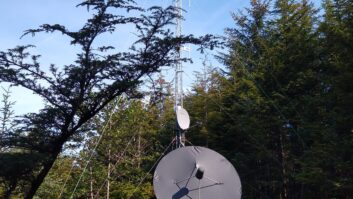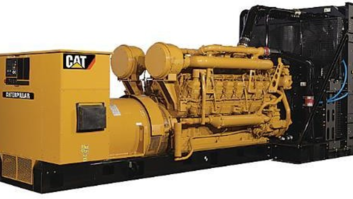Power Generator Maintenance
Sep 1, 2005 12:00 PM, By Rolin Lintag
The power generator (genset) used for broadcast facilities should be treated as an integral part of the broadcast system as far as maintenance is concerned. It is easy to take it for granted until the ac mains fail and the back-up power has failed to get the station back on the air. Implementing an effective preventive maintenance program on the genset system will prevent unpleasant surprises.

A genset system can be divided into two major parts: the dynamo that produces the electricity and the engine that moves it.
A well-protected dynamo will rarely experience operational problems unless a catastrophic event burns the windings or loses one of the phases. Aside from monitoring the presence of all three phase voltages and current, there is not much on-site maintenance on the dynamo that can be done by station personnel.
The engine, however, is a machine that requires more attention on a regular basis. There are several parameters to be observed and prerequisites to be satisfied to ensure that the engine will operate as expected. Just like maintaining a car, there are basic checks that need to be done to ensure that it will start when called for and keep on running as needed.
Systems check

The battery connections, electrolyte and charger are simple items to check.
The engine requires proper and adequate cooling when in operation. Big engines, like those used to supply power to broadcast facilities, use air and water (glycol mixture) cooling. Adequate air should be present so as not to choke the genset while in operation. This means that air openings of the genset building are clear (louvers are open during operation) and that the air filter of the engine is not clogged. Installing an air-filter restriction indicator will facilitate inspection of the health of the air filter.
The water coolant, usually a mixture of automotive glycol and water, should be at the correct level prior to genset operation. Because it is usually hard to determine the coolant level without opening the pressure valve on top of the radiator, it is best to install a sight glass for a quick inspection. Also, ensure that the coolant being used has the right freezing point for the geographic location. Check the glycol freezing point before winter comes and act accordingly. Also check the water hoses for the radiator for cracks or loose connections due to the steam temperatures they must endure during operation. It is best to inspect these on a regular basis because steam leaks can deplete the radiator of its coolant after hours of operation.
Big engines require a starter motor to initiate operation. This starter motor requires the dc voltage supplied by the battery to run. Make sure that the battery can indeed make the starter motor run. This means that the proper battery should be in place and that it is regularly checked for its output voltage and ability to provide the required current. Take note that a battery may show the right voltage but its output is severely limited if there is a weak cell due to lack of electrolyte or damaged electrodes. A symptom of this is a drop in voltage under load. Similar symptoms will show also if the terminal connections are loose or corroded. Any checks performed on the battery should first determine if the terminal connections are intact and that the wires used are continuous. Check the battery charger as well to ensure that it is properly charging the battery. Although maintenance-free sealed batteries are best to use, the common lead acid batteries can do the job at a lesser price. Check the health and level of the electrolyte for lead acid types on a regular basis.

Check all hoses and connections for leaks and cracks.
Check the fluids
The life of the engine can be severely shortened by lack of proper lubricating oil. Ensure that there is enough oil in the engine before operating it, taking note of the manufacturer’s recommendations about oil and filter change and monitoring. This is one of the reasons why an hour meter is necessary to log the hours of operation of the engine. Properly reseat or reseal the cap of the oil dipstick after each inspection. This precaution prevents oil spillage during operation.
Make sure that the fuel filter is replaced according to manufacturer’s recommendation. Inspect the fuel lines for leaks and employ qualified personnel to do repairs as needed. This is more critical natural gas is used. Checks for leaks can be as simple as spraying soap water on pipe connections and watching for bubbles from escaping gas. Ice shields protecting fuel pipes should also be inspected before winter comes. Off course, you want to make sure that fuel is replaced when needed so regular checks on the fuel tank capacity should form part of the inspections.
Suggested maintenance schedule
This suggested schedule serves as an example. The final schedule for your installation may vary, and it’s a good idea to have the schedule reviewed by the genset manufacturer or dealer to include factors that are appropriate to your genset model, size and age of the unit.
Daily:
- Check fuel tank and record hour-meter reading. Refill fuel tank as needed.
- Inspect building interior for cleanliness and any oil spills. Clean or repair as needed.
Weekly

An hour meter is useful to keep detailed records of genset maintenance.
- Check the battery terminal connections for corrosion and looseness. Check for integrity of wire connections from the battery to the starter connections.
- Check the coolant level on the radiator. Refill as necessary.
- Check the engine oil for proper level and refill as necessary. Replace oil and filter as per manufacturer’s recommendation.
- Check the fuel connections for leaks (for gas fuel). Get qualified personnel for immediate repair.
- Verify that the battery charger is working as expected.
- Test load operate the generator for preparedness. Record all front panel parameters. Verify that operation shows proper voltage regulation and frequency.
Monthly:
- Check battery voltage with a DMM and record readings.
- Check electrolyte level and specific gravity. Take appropriate action as needed (for lead-acid battery only).
- Check the air filter. Replace as necessary.
- Check water hoses for cracks or leaks and replace as necessary.
Annually:
- Load bank testing, compression and timing checks by qualified manufacturer’s representative.
Lintag is an RF engineer for Victory Television Network in Little Rock, AR.












